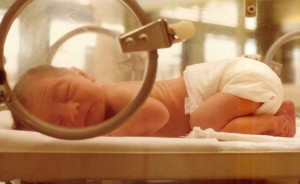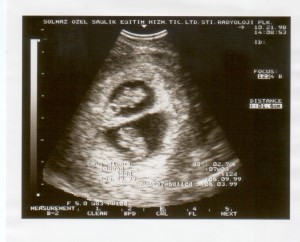With all pregnancies, it’s very important to become familiar with symptoms that could indicate the signs of early or preterm labor. This is especially important with a multiple pregnancy because preterm labor is much more common than with a single baby on the way.
The fact that your uterus is not only growing larger, but because of the double, triple or more babies growing and rapidly taking up space, the uterus is also growing at a faster rate than if you were carrying one baby. With a single pregnancy, as the uterus grows, it naturally contracts as part of the growth process. You’ll notice a slight pulling or tightening/hardening sensation in the lower abdomen that is completely painless and harmless, which may last for a few seconds. However, this more rapid rate of growth with a multiple pregnancy can cause the uterus to become irritable and you may notice normal growth contractions become more frequent as you reach about mid-point in your second trimester (approx. 20-22 weeks).
 If the contractions begin to increase in frequency, and the tightness and temporarily hardening of the lower abdomen is accompanied by pain (mild to moderate), then your contractions may no longer be harmless. They may be becoming productive contractions, which means that cervical effacement (shortening) may be starting. Effacement occurs prior to cervical dilation during active labor, and you don’t wanna go there yet!
If the contractions begin to increase in frequency, and the tightness and temporarily hardening of the lower abdomen is accompanied by pain (mild to moderate), then your contractions may no longer be harmless. They may be becoming productive contractions, which means that cervical effacement (shortening) may be starting. Effacement occurs prior to cervical dilation during active labor, and you don’t wanna go there yet!
So, sit down, breathe deeply and relax. Stress and panic will only make the situation worse. Call your health care provider (at any time of day) and speak with an on-call nurse. She will immediately advise you to get off your feet (preferably lie down on your left side), and drink a full 8-10 ounces of water. Contractions may be brought on or worsened if you’re water intake is low and you’ve become even slightly dehydrated. Dehydration is the number one cause of muscle pain, tightening and cramping … ask any athlete or sports enthusiast. Your uterus is a big, powerful muscle and ligament-bound organ, and the muscles are very sensitive to dehydration, so DRINK A LOT OF WATER!
Are You in Preterm Labor? If your contractions continue for a good 30 minutes after hydrating yourself, call the nurse back, and she may suggest that you come into the office or go directly to the Labor & Delivery Unit at the hospital. The likelihood of actually delivering is low because of available medications that can be given to you to stop the contractions. An anti-contraction medication called Terbutaline (actually indicated for asthma treatment) may be administered first via injection after you are placed in a hospital bed. Fetal monitors are positioned on your abdomen (secured in place by velcro held stretchy belts) to keep constant tabs on the babies’ heartbeats to identify any fetal distress. Also attached to your abdomen is a contraction monitor to identify the frequency and intensity of your contractions. You can also expect a clear fluid IV to be started to quickly further hydrate you. Usually, when a bout of preterm labor occurs early in your pregnancy, some good hydration and one good dose of terbutaline may be all that’s needed to do the trick! Once the contractions have stopped and have not occurred for more than an hour or two, you can expect to be sent home.
Prescription: Partial or Complete Bed Rest. You might be sent home with the orders to start taking it more easy, to be mindful of your water intake, and perhaps you’ll be given a prescription for oral Terbutaline to taken as needed. If another episode occurs again soon after, you may be asked to greatly cut back on or eliminate all activities, which will include going to work. You may be placed on complete bed rest until you reach 34 weeks gestation, when you’ll be able to resume some light activities no longer at risk of delivering dangerously premature babies. In twins or with single births, 34 weeks gestation is the point at which all doctors strive to reach in regards to the baby’(ies) development and lowered risk of complications associated with prematurity.
Bed Rest Attitude? Gratitude! Because of the fact that your babies didn’t arrive profoundly early as a result of your 2 or more bouts of preterm labor, consider yourself extremely blessed and fortunate! Each day on bed rest is a challenge, especially if you have older children, but it is definitely a survivable, temporary situation. Count each day as a blessing and know that you are doing what is BEST for your babies: keeping them inside where they will grow stronger and healthier with each passing day, and giving them them the absolute HEALTHIEST start to their lives by committing yourself (and sacrificing) to reaching the minimum of 34 weeks. Anything past 36 weeks is “gravy” according the the health specialists, so keep focused, resolved, committed and try to keep the complaints to a minimum! 😉 And remember, this too will pass, and will be worth every minute of every hour of every day. For more info, advice and suggestions on coping with pregnancy bed rest, look for the article Surviving Bed Rest on this site!
Nature’s Timetable. You’ve followed your doctor’s orders to the letter, and only gotten off the bed or couch for bathroom trips, two to three quick showers per week, and been driven to and from your OB appointments. By following this strict routine, you are doing all that you can do to ensure that your pregnancy continues. Just be patient and take it one day at a time, because each day that you stay pregnant matters in the health and long-term wellness of your babies.
However, with all that you’ve done (or rather, not done) for now weeks or even months, labor begins again. Another (and perhaps final) trip to the hospital is in order again, and if your pregnancy gestation is prior to 34 weeks, your doctor will take all steps to stop labor. If two rounds of Terbutaline is no longer effective (your body will build up a resistance to it eventually), your doctor may start an IV drip of magnesium sulfate. This treatment is very effective in stopping labor contractions, but as it directly affects your uterine muscles, it also affects your other muscles. You’ll feel warm all over (even your tongue) and you may become very weak and sleepy. Magnesium sulfate therapy lasts between 24 and 48 hours, so hunker down and go with it. Unfortunately, side-effects do exist that are unpleasant. Nausea, vomiting and heartburn often accompany this therapy, but if your body is not tolerating the medication as these symptoms may indicate, your doctor may opt to discontinue therapy. Regular-interval blood is taken to monitor your tolerance to this drug therapy throughout this treatment, and your body may indicate intolerance to the “mag”, as it is affectionately called. Another medication that may be introduced at this point is called Procardia, (generically called Nifedipine, indicated for cardiac patients) which is being found as more effective than Terbutaline for labor-stopping purposes.
 Birth Day! With all the measures taken to prolong your pregnancy, you may be looking at an extension of one to two more weeks or more! However, nature (God) has a way of sometimes overriding all the ways humanly possible to give your babies a later birthday. If your doctor sees that, despite all of the treatments, your labor is simply progressing, its time to accept that these babies are coming! If you are less than 36 weeks along, the best hands you and your babies can be in would be a hospital with a Level 3 NICU (neonatal or newborn intensive care unit). This is the highest level of infant care, and you’re in the best place. If your babies are under 30 weeks, a cesarean section (C-section) will be done. If, however, your babies are over 30 weeks (the skull bones are now firmer), and their positions are head down and engaged to enter the birth canal, you might be given the choice to deliver vaginally. If you are carrying more than two babies, however, you can count on having a C-section.
Birth Day! With all the measures taken to prolong your pregnancy, you may be looking at an extension of one to two more weeks or more! However, nature (God) has a way of sometimes overriding all the ways humanly possible to give your babies a later birthday. If your doctor sees that, despite all of the treatments, your labor is simply progressing, its time to accept that these babies are coming! If you are less than 36 weeks along, the best hands you and your babies can be in would be a hospital with a Level 3 NICU (neonatal or newborn intensive care unit). This is the highest level of infant care, and you’re in the best place. If your babies are under 30 weeks, a cesarean section (C-section) will be done. If, however, your babies are over 30 weeks (the skull bones are now firmer), and their positions are head down and engaged to enter the birth canal, you might be given the choice to deliver vaginally. If you are carrying more than two babies, however, you can count on having a C-section.
Congratulations ARE in order! Although you may have just gone through days of drama and trauma, and the unwanted and unexpected early births of your babies happened despite all your hopes, prayers, and actions taken by your health care team, your babies have arrived, and you need to know that this is (although bitter-sweet) an occasion for celebration! If your babies are very premature (arriving before 28 weeks), a high level of care and time will be needed, and there may be one or more short or long-term residual effects due to this level of prematurity.
Babies arriving between 30-34 weeks stand a much better chance at simply growing with careful care and monitoring before being sent home with you. Generally, the protocol standards neonatologists use to decide that a baby is ready for hospital release would be weight, overall health, and gestational age. Rarely do preemies go home before they reach 37 weeks (what would have been) gestational age. The weight goal doctors like to see reached is between 1800-2000 grams (4 to 4.5 pounds). Some doctors like to see closer to 5 lbs. Other circumstances may also factor in, however, such as illness and surgery recovery, and apnea/bradycardia (referred to as “A’s & B’s”) episodes, which are very common heart/lung/breathing maturity conditions, may be occurring too frequently. Another alternative to staying hospitalized after 4.5-5 lbs. is reached and A’s &B’s are the only issue, may be to take the babies home but with the security of portable monitors that can alert you as you that an episode has occurred so you can quickly stimulate the baby to take that breath and thus prevent any further problems. SIDS (Sudden Infant Death Syndrome) occurs much more frequently and the risk time is longer with preemies.
Welcome to the world of parenthood! Buckle your seat belt and prepare now for the craziest ride of your life! Be encouraged and take comfort that despite your baby(s)’s premature arrival, and the challenges it may have presented or may still present, you will find the strength through love, devotion and commitment to be the best mother for your baby(s). Trust me, you will find the strength, and YOU’LL DO GREAT!
For other resources on premature labor’s signs, causes, treatments and prevention, please visit American Pregnancy Association and The National Institute of Child Health and Human Development.
Premature Babies. Due to the many medical complications that can develop as a result of premature birth, please refer to Premature Infant – Frequently Asked Questions, a resource on WebMD.com for a comprehensive report on what can be expected after the delivery of your premature baby(ies). Another source to check out is a research review that I co-wrote with a fellow student in a nursing school prerequisite class that I took a couple of years ago on the Developmental Interventions that can be done to improve chances of healthy growth in premature infants. Here is the link: Premature Infants/Developmental Intervention.
REMEMBER that an ounce of prevention is worth a pound of cure.
So, let’s keep those babies cookin’ inside as long as possible!
My personal preterm labor and delivery experiences …
… are basically described in the above article. I went on complete bed rest with all of my pregnancies somewhere between weeks 18-22. I, more or less, experienced each of the steps listed above, with some slight variations with each pregnancy. My second pregnancy was stretched to 35 weeks, due to, I believe, the fact that I went home with a subcutaneous intravenous line inserted in my thigh, which was attached to a little computer remote that administered regular doses of Terbutaline into my bloodstream. A visiting nurse came once per week to check my and the babies’ vitals, and alternate my I.V site from one thigh to the other. Along with this treatment came a monitoring system that I was required to use. Two to three times per day, I was required to belt myself to a contraction monitor and leave it on to read any contraction activity for one hour. Immediately afterward, I remotely transmitted the data via my telephone to an OB nurse who would read the data and call me back with the results. I was allowed five or so mild contractions per hour. One early morning just past my 35th week, the contractions numbered 27, and I was sent to the hospital. Trust me, I knew how bad I was feeling and predicted what my off-premises nurse’s instructions would be! My son (the trail blazer) arrived via vaginal birth at 4 lbs, 13 oz, and my daughter (who was out in 2 pushes) weighed 4 lbs, 6 oz. Neither had any health problems and stayed in the NICU for one week to grow a bit and overcome some mild jaundice, and are now very active, happy 11-yr-olds.
My first and my third pregnancies’ preterm bouts, however, were different. At 30 weeks with my first set of twins I went into preterm labor for the 3rd time, and although hospitalized and on treatments, my water broke at 30 weeks and 5 days. My daughters (born weighing 2 lbs., 14 oz and 3 lbs, 1 oz), were hospitalized for 6 weeks and had some health issues, but nothing long-term. They are now strong, smart, healthy 16-year-olds.
My water broke (after 2 hospital-stay bouts of preterm labor placing me on oral Terbutaline) one afternoon with no warning when my third set were 30 weeks and 5 days along, coincidentally and ironically the exact gestational age as my first set of twins. Although a vaginal birth was preferable, I was advised to go ahead with a C-section in case the babies were just too small. They were born at 4 lbs, 1 oz and 3 lbs., 11 oz. … much bigger than my daughters. Perhaps (and it s suspected) I was off my conception date a week or so. My now 3-yr-old sons are typical, healthy, and BUSY little boys!
Blessings ~

 More often, mom and dad want the answer to this question before the babies arrive, and hope there will be a way to find out!
More often, mom and dad want the answer to this question before the babies arrive, and hope there will be a way to find out! Fraternal (dizygotic = two zygotes) twins occur when two separate eggs are fertilized by two separate sperm. They are basically the same as any sibling would be to another, but are conceived within a day or two of the other, share their mother’s uterus at the same time, and are usually born within minutes of each other.
Fraternal (dizygotic = two zygotes) twins occur when two separate eggs are fertilized by two separate sperm. They are basically the same as any sibling would be to another, but are conceived within a day or two of the other, share their mother’s uterus at the same time, and are usually born within minutes of each other. together to appear as one placenta. Fraternal twins do not share the same sac.
together to appear as one placenta. Fraternal twins do not share the same sac.






